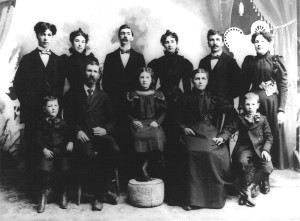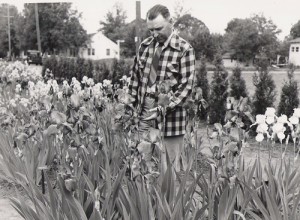Richard “Rick” Ernst has done a great deal of genealogical study about the Cooley family – his mother’s ancestors – tracing them back to the 1740s in Virginia. Like other American pioneers, subsequent generations of Cooleys moved westward. Some were among Silverton’s early settlers and through the years the name Cooley has become world renowned for the commercial growing of irises.
The family’s story is one of hardships and courage, of meeting challenges and making changes.
In the 1840s, Cornelius Cooley was living with his wife, Dolly, and their four young children in Missouri, when at the age of 39 he died and the family had to be broken up.
A son, Mathias, was just 7 when his father died. He was sent to live with William Wilson, whose first wife, Hannah, had been his aunt; but Wilson had remarried, so young Mathias was to be raised by an uncle by marriage and his new wife.
In 1845, William Wilson and family joined members of the Cooley family – Eli, Jackson and Christopher Columbus Cooley and their sisters – and left Independence, Mo., on a wagon train journey on the Oregon Trail.
“They got a late start,” said Ernst. “At Ft. Boise, Stephen Meek said he’d lead them on a new route … their only map was an 1840 U.S. Army map of the Oregon Territory. If you’ve ever seen one, you’d wonder how anyone could make it anywhere.”
It was a drought year and the terrain didn’t look like what was depicted on the map. The detour took several extra weeks and their food ran out.
“Things started going bad. They nearly starved,” Ernst said. The group gave up on Meek’s route and headed north to The Dalles. “The only thing they had to eat was salmon skins they’d traded with the Indians.”
When the emigrants got to The Dalles, the missionaries there didn’t have much food to offer the 195 wagons full of travelers either. They were desperate and hungry.
“William Wilson wouldn’t wait for some dried beans to rehydrate before he ate them. They swelled in his stomach and it killed him,” Ernst related. This left 8-year-old Mathias in the care of a woman he hardly knew.
But they had made it to Oregon. His foster mother quickly remarried to a man named David Hill, and they settled in the area that became Hillsboro. Mathias left this home at age 13 and went to live with his uncle Jackson Cooley, a carpenter and wagonmaker who taught him the trade and Mathias taught himself to play the fiddle.
Eventually he married Willamina Smith and took up farming on Downs Road, outside Silverton. “They had nine children and he taught each of them to play a different instrument.”
The Cooley Orchestra played for local dances and several of the sons joined the Silverton Citizens Band. One of the sons, Cornelius John Cooley, known as C.J., married Eliza Haberzettel and in 1899 they had their only child, Rholin.
Rholin Cooley took a job with the post office and served two terms as Silverton’s mayor. But it is his avocation that led to the Cooley name becoming renowned.
“In 1924, the family doctor, Dr. Rudolph Kleinsorge, gave Rholin some irises,” Ernst said. “My grandfather called them ‘a strangely fascinating flower.’ In 1928 he and my grandmother (Pauline) published their first catalog.”
Ernst said the couple became extremely interested in irises and borrowed $1,000 from Rholin’s father, C.J., to start a commercial iris business. “They made enough money their first year (and) repaid the loan. For the next 22 years the business grew and expanded – not a lot, but a little.”
“After 22 years, my grandfather retired from the post office. At that time they only grew irises on 10 or 15 acres, so the business was small,” Ernst said.
Rholin and Pauline had a son, Keith; and a daughter, Miriam. She married Larry Ernst.
Rholin died in 1971 and business leadership was taken over by Larry Ernst and Keith Cooley, who “didn’t particularly like the business,” said Rick, Larry’s son. Later Larry Ernst bought out Keith Cooley’s interest.
by Larry Ernst and Keith Cooley, who “didn’t particularly like the business,” said Rick, Larry’s son. Later Larry Ernst bought out Keith Cooley’s interest.
“My dad expanded the acreage and wholesale business and changed some of the cultural methods,” he said.
“I started working here when I was 12. I went out in the field and tagged, and packed plants, too.”
He graduated from Silverton High School in 1971 and four years later joined the Navy. He returned in 1980.
“By that time the business was large enough to support another family.”
Rick’s sister, Georgie, came to work at Cooley’s Gardens in the mid-1980s and in 1987 her husband, Larry Johnson, and sister, Judy Nunn, joined the family firm.
“At that time we were growing on about 100 acres. I began further expanding the wholesale business,” Ernst said. With the expansion came the need for more acreage. They bought more farms.
“In 1992 we were raising on about 280 acres,” Ernst said. Cooley’s Gardens was now the largest iris grower in the world.
But time changes things.
One of the company’s biggest wholesale accounts, which normally purchased 2 million irises a year, went into bankruptcy and in its restructured form purchased only 200,000. “The rest we plowed under.”
“Then we were hit by a 10 percent hike in minimum wage each of three years,” said Ernst. ”About 75 percent of our costs are field labor and we couldn’t pass on the cost to our customers. We had to operate at a loss.”
Ernst took the bull by the horns.
“We had to shake things up a little bit and make changes,” he said.
He began selling off farms they had acquired in the ’80s. “The last one we sold allowed us to continue operating.”
Larry Ernst had a stroke and was unable to continue working. Over time Judy Nunn, Larry and Georgie Johnson retired. “That left me,” said Rick Ernst. “It was too much.”
Ernst decided to close down the wholesale division and concentrate on retail sales. The current economic downturn led to a reduction in size of Cooley’s catalog this year and planting was reduced to 5 acres. The display gardens will continue to welcome visitors in the spring.
“We’ve gotten through the year with just two to five employees,” Ernst said.
During its existence, Cooley’s Gardens has won numerous awards for its hybrids.
“Last year we won the Wister Medal – the highest award a tall bearded iris can receive,” Ernst said. “We had probably over 50 honorable mentions and a dozen Awards of Merit plus numerous awards from Italy and Russia and regional awards throughout the U.S.” In 1990, Cooley’s Gardens earned Oregon State University’s
Family Business of the Year Award.
Just as the boy Mathias Cooley survived an ordeal crossing the continent, Cooley’s Gardens has overcome difficulties.
It now moves into its 82nd year.
